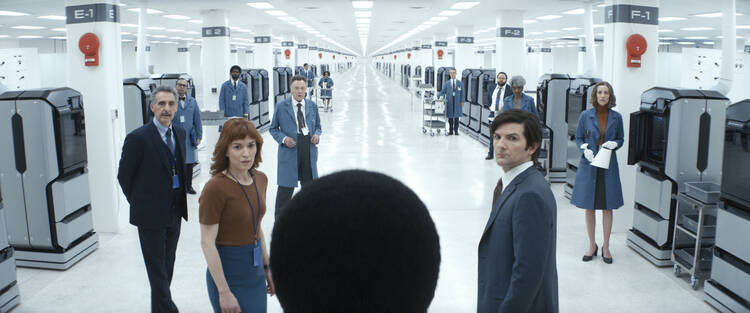The word “liminal” has taken on a very particular meaning for a lot of folks on Twitter. A liminal space is a term for a vacant waiting room, an overlong hallway or an empty stairwell: somewhere eerie with nondescript features and no occupants. Twitter users agree that something about these spots is otherworldly and unnerving. Entire accounts are devoted to finding and sharing liminal spaces.
Of course, liminal really just means transitional, the unanchored state between where we were and where we will be. Liminality is only scary when we consider being trapped there, unable to move forward or return to our origin.
The bulk of the Emmy-nominated TV series “Severance,”from Apple TV+, takes place in a liminal world.
The bulk of the Emmy-nominated TV series “Severance,”from Apple TV+, takes place in a liminal world. The show follows four coworkers, working 9 to 5 at a corporate leviathan called Lumon Industries, wandering through a web of otherwise empty, pristine white offices and corridors lit by fluorescent bulbs. Each detail of their building, the linoleum tiles and gently worn swivel chairs, evokes the same discomfort as, say, an abandoned mini-golf course.
The characters of “Severance” are trapped in liminal lives, as well. The protagonists have agreed to a surgical implant in their brains that blocks their memories of work during their free time, and vice versa. In effect, they are each two people living in one body: one who does not know what they do for a living, and one who was born in the office and will never leave.
The series’ director, Ben Stiller, (yep, that Ben Stiller) starts with a straightforward premise that might not sound too bad to most of us. Who hasn’t spent a workday staring at the clock and wishing we could fast-forward to the end? Turn our brains off? Over the course of the first few episodes, though, the show does an excellent job of demonstrating the mind-bending and insidious implications of the severance surgery.
For example, Britt Lower plays Helly, a new employee who is justifiably freaked out when she wakes up in the office with no memories. She requests to leave. Her supervisor Mark, played by Adam Scott, walks her to an exit. She opens the door, steps out and suddenly finds herself back in the hallway with Mark. When she demands to know why Lumon is detaining her, Mark informs her that she did in fact leave and was gone for a few minutes.
The show critiques the faceless American company, for whom workers are interchangeable cogs and poor mental health is the collateral damage of productivity.
Her non-work personality, her “outie,” chose to come back, so from Helly’s “innie” perspective, it’s like she never left. Later in the show, we get to see the conversation that her “outie” had, but in the moment, we experience the jarring lapse in time the way she does.
This is the most intriguing and original feature of “Severance”: The work personalities could quit their job at any time—but only if their “outies” approve. With no memories of what their “innie” experiences, the average “outie” has no reason to approve a request to quit. And for the “innie,” ending the job would mean their death as a sentient being.
The show critiques the faceless American company, for whom workers are interchangeable cogs and poor mental health is the collateral damage of productivity. More intriguing, it presents philosophical questions about what role our trauma plays in our personalities.
Mark undergoes the severance procedure after losing his wife in a car crash, hoping to forget about his inner pain for just a few hours each day. The arrangement initially works the way he had hoped. His work personality is happy in the office, and his “outie” takes some solace knowing that part of himself can live blissfully ignorant for part of the day.
However, the effect, as we see it play out over the course of the first season, is that “outie” Mark is trapped just as his “innie” is. He knows that a version of him exists that does not feel the pain of his wife’s death, and that fact deters him from starting the painful healing process. Rather than try to move on, he drinks and waits to go back to work. Every night looks the same.
To me, all of this adds up to a pretty profound statement about how human beings process trauma.
As “outie” Mark wonders more and more about his job at Lumon, and with the help of other characters uncovers disjointed clues to his occupation, he finds some stability in his personal life as well. Dates go better, and he drinks less. He begins to move away from the complacency that had taken hold of him. Although his trajectory is not straight, over the course of the season he overcomes much of the inertia he had when we met him.
To me, all of this adds up to a pretty profound statement about how human beings process trauma. When the bad things in life come for us, we might try to wrestle them under control with work (or exercise, or diet, or whatever solutions we turn to). There is an expectation that strong, self-sufficient people can deal with their problems on their own time. They push through in stoic solitude and keep living their lives. We have an unspoken reverence for those who can keep their personal turmoil and work productivity separate.
But we cannot distract our way out of grief, loneliness or fear. We cannot remain at the limen of our emotions and expect to ever recover. Our trauma requires time for reflection and healing, just like a physical wound, and in today’s work-obsessed world we have little room for that. “Severance” pushes us to consider how we prioritize productivity over growing as a human being.
As work-from-home jobs free people from their cubicles, the corporate wasteland setting of “Severance” might start to fade from cultural memory. The new liminal challenge that many of us have found during the pandemic is defining the boundaries of work hours when our bedrooms double as our offices.
Does working from anywhere mean that everywhere is our workplace? Can we set aside time for our emotions and our growth if we never physically leave the space meant for working? I have found that balance to be a challenge myself over the last two years. I suspect that the show’s questions about our relationship to our jobs will grow only more relevant.







